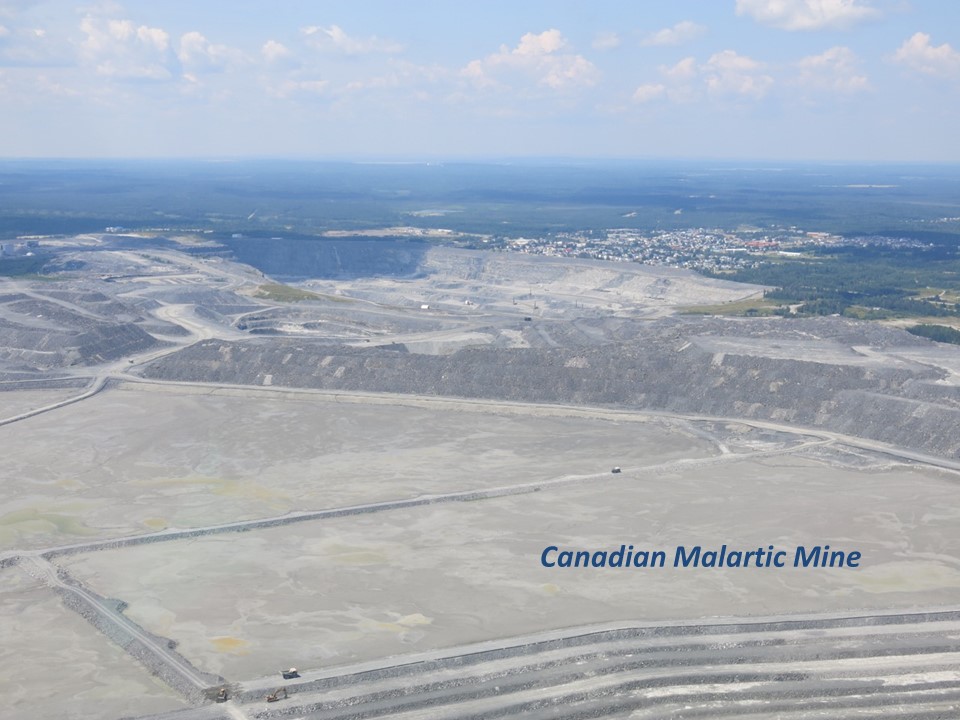(Letter presented to Kamloops City Concil's Public Presentation Session on 15 March 2016)
Mr. Mayor, Councilors,
First, I would like to thank you for allowing me to speak here today, in the beautiful city of Kamloops. I would also like to thank MiningWatch Canada for this opportunity, and the people of Kamloops for their warm welcome and generosity since my arrival on Sunday.
My name is Diane Gagnon, born and raised in the Abitibi mining region, Quebec, and now a resident of Malartic –home to the largest gold mine and the largest open pit mine on the edge of a city in Canada.
I am a mother of four kids, and soon grand-mother of my sixth grand-kid. My father was a miner. I work myself as an executive coordinator for a company which services large mining clients in the region with heavy equipment (tractors, rock breakers, steel structures, etc.).
I am generally not against mining. But the story I will share with you today should serve as a serious cautionary tale about the impacts that a large open pit like AJAX would have on your people’s health, safety, well-being, and quality of life in Kamloops.
Since the Canadian Malartic open pit mine started operating in 2011, we are experiencing serious problems and community impacts related to daily blasting, ground tremors, air blasts, dust, and noise from the mine. The mine has also created deep community divisions, and even at times family divisions, particularly between those that benefit from the mine, and those that do not benefit and suffer greater impacts from its presence.
Where to begin?
Blasting, ground tremors, air suppression, house shaking, are amongst the worse impacts we experience from the Canadian Malartic mine. Every day, between 11am and 3pm, the mine blasts anywhere between 100 000 and 200 000 of tons of rocks. Those blasts are heard or felt up to 2.0km away, and sometimes more, depending on the weather condition. The blasts can displace objects and furniture in the house, paintings on the walls, or even create cracking overtime in the walls and foundations.
People in town are also starting to experience what they call the ‘11-to-3 o’clock Syndrome,’ where stress and anxiety take over the normal course of daily life, apprehending when the next blast will take place. The effects are also harder on people with higher sensitivity to noise, stress and anxiety; babies and young infants that are startled and awaken from their nap crying; people working nightshifts and having their daily sleep interrupted; senior people in nursing-homes; or people with mental disabilities, like my son, Samuel, who is autistic, and never had to experience those daily episodes of higher stress before the mine arrived.
Dust is another big problem. Before the mine arrived, we never had that much black dust falling on our property, our houses, our cars, our decks, our swimming pools, our gardens, our school yards, etc. The blasting, trucking, and tailings from the mine seem to be the main sources of dusts. There is dust all year long, but it is worse in the summer, when the climate is dry, or when the winds are blowing into town. Many of our community members cannot fully enjoy their property anymore. They have to shut their doors and keep windows closed to avoid dust inside. They don’t dry their clothes outside anymore.
The fine dust (the invisible dust) also affects those with respiratory problems. Although this is much more difficult to prove medically, or statistically, there are countless stories of people claiming to have more respiratory problems since the mine moved in (e.g. asthma). Some people using air filters and assisted respirators now have to change their filters much more often (e.g. days instead of weeks).
The community group I work with has recently initiated a joint study with the regional Public Health Authority on the physical health impacts from being exposed to dust from the mine –particularly for people with higher sensitivity to air pollution, people already affected with chronic illnesses, infants and children.
Originally permitted to mine 500 million tons (2.5km X 0.8km open pit), the company is now seeking a permit to double the size of the mine (3.5km pit, over 1.0 billion tons of ore and waste rocks). This would mean displacing the main local highway and affecting other neighborhoods.
Homeowners want to sell their houses and move away, but cannot find any buyers.
In 2015, the Quebec health authorities published two reports[1] highlighting that impacts on our community of 3,200 were greater than assessed and anticipated at the outset. In the latest study[2] published in September 2015, the Regional Public Health Authority is concerned about the proportion of people claiming to be ‘affected’ (A) or ‘highly affected’ (HA) by various mine disturbances and impacts. More specifically, the study found that:
- Over a third of respondents in Malartic claim to be A or HA by the mine;[3]
- The proportion of people A or HA climbs up to 54% for noise, 74% for dust and 78% for ground tremors in neighborhoods closest to the mine (less 0.7km);[4]
- In neighborhoods furthest from the mine (up to 2.0-2.5km), the proportion of people A or HA is still significant with 15-26% (noise), 17-41% (ground tremors), and 27-48% (dust);[5]
- Over a third of the population want to move or be relocated due to the mine’s impacts (up to a quarter of the population in the neighborhoods furthest from the mine);[6]
In the end, the Public Health Authority recommends to both the operator and regulator to find ways to stop those levels of disturbances, or to offer a relocation and compensation package to those affected by the mine.
Despite having spent over a 100 million dollars to date in relocation and mitigation measures, and despite claiming to use best available practices and technologies, the mine is incapable of meeting regulated levels of dust emissions, ground tremors, air blasts, and noise. This open pit mine holds the record in the province, across all industries, with 171 environmental infractions for over 2000 non-compliances since construction started in 2009.[7] But lack of enforcement and too small fines by the Quebec Ministry of Environment have failed to compel the company to comply with regulations. Worse, the mine permit has been changed over 4 times since 2011, in many cases to lower some of the constraints that the company was not able to respect.
Even economically, the benefits are not those that were promised. Businesses have closed downtown and Malartic is the only community in the region having seen a decrease in the population (from over to 3,500 before the mine started to about 3,200 currently).
When I moved back to Malartic in 2011, just when the mine began to operate, I had no idea about how bad the mine would impact me, my family, and many other community members.
In fact, in the years leading to the permitting of the mine, we were again-and-again told by the company’s experts, the regulators, and even some of the City Councilors at the time, that the mine ‘would only bring about positive impacts’ for the community; that there would be ‘no significant negative impacts;’ that ‘all laws and regulations’ would be respected.
I can now tell you that those claims were simply not true. They were either straight lies, or a clear manifestation of blunt incompetency of those claiming to be ‘experts’ and acting ‘responsibly’ to protect people’s health, safety, and well-being. It is the people that are left behind today as the first victims of those poor assessments and judgments made back then, to the point that we are now considering to file a class action suit against the company in April.
At the time, we had overheard some cautionary statements made by local and national groups, like MiningWatch Canada, but paid little attention to them, putting more trust in those company experts, regulators, and Councilors we entrusted with our votes. I have to admit today that we were wrong. I hope you will not make the same mistake.
In closing, I would like to state that the citizens of Kamloops would benefit from the knowledge and insights from other communities where open pit mining has encroached upon city limits, such as our community. As such, I would like to extend an invitation to the City Council and the City of Kamloops to send a delegation to come and visit Malartic, to do a comprehensive tour, and observe the impacts on our community.
Thank you again for your time and consideration,
Sincerely,
____________________
Diane Gagnon
Citizen of Malartic
Representative of the Comite Citoyens de la Zone Sud de Malartic (700 households)
[1] http://www.quebecmeilleuremine.org/communique/nouvelle-enqu-te-la-sant-publique-sonne-l-alarme-et-presse-le-gouvernement-d-intervenir-l
[2] http://miningwatch.ca/sites/default/files/2015-publichealthauthorityreport-malarticmine-summary.pdf, http://www.sante-abitibi-temiscamingue.gouv.qc.ca/fileadmin/documents/agence/Sante_publique/Ma_sante_et_environnement/industrie_miniere/2015-09-21_Rapport_sondage_DSPu.pdf
[3] See in particular figures 60 & 69 in appendices: http://www.sante-abitibi-temiscamingue.gouv.qc.ca/fileadmin/documents/agence/Sante_publique/Ma_sante_et_environnement/industrie_miniere/2015-09-21_Sondage_DSPu_Annexes.pdf
[4] See in particular figures 61, 70, and 71 in appendices
[5] See in particular figures 61, 70, and 71 in appendices
[6] See figure 32 in main report
[7] http://miningwatch.ca/sites/default/files/2016-02-rapport-malartic-mddelcc.pdf








